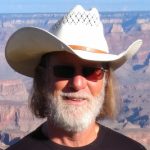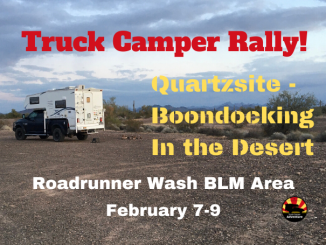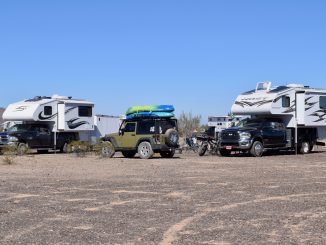
In the United States we have been blessed with 640 million acres of federal public land. As a matter of fact, federal land comprises 28 percent of the total land area in our country. This public land includes national forests, Bureau of Land Management land, national parks, US Fish and Wildlife Refuges, US Army Corps of Engineers, and other government entities. Activities on these lands run the gamut from camping, fishing, hunting, and bird watching to rock climbing, photography, and stargazing, practically anything in which a truck camper owner would be interested.
As Americans, we are blessed with the best public lands in the world. Everyone knows about the big name national parks like the Grand Canyon, Glacier National Park, Death Valley, and the Great Smoky Mountains, but lesser known parks and places are equally spectacular. If you’ve never visited the Kaibab National Forest in northern Arizona, the Black Canyon BLM land near Gunnison, Colorado, Utah’s Grand Staircase, and the Everglades National Park in Florida, you’re really missing out.
Dispersed camping or boondocking, in particular, has grown in popularity in recent years. We’ve seen this first-hand in Arizona, the state where we currently live. Whether people are just out for the weekend or permanently living and working in a recreational vehicle, more and more people are enjoying what the state has to offer.
But we are also seeing something happening that is pretty disturbing—the increase in litter and human caused wildfires. Unfortunately, the situation is getting worse and doesn’t appear to be getting any better. Our fear is that it will lead ultimately to not only the closures of more public properties, but also to the obliteration of entire forests due to fire.
The amount of trash we find at campsites, along roads, in rest areas, and on the land, in general, is appalling. Beer and liquor bottles, food wrappers, old clothing, broken furniture, empty oil containers, automobile batteries—even burnt-out, bullet-riddled vehicles have been found where we’ve camped on public land.



Documentation of what we are talking about can be seen on our website. We’ve found garbage next to and on top of trash bins, on the ground, in parking lots, on beaches, and on hiking paths. We’ve even found litter and debris around “no dumping” signs. When people do this it’s like they are saying to us, “we’ve had a great time here and left our trash for you, would you be kind enough to take it to the dump for us?” Volunteers, like us, who help clean up after others has helped stem the tide, but more needs to be done.
Yet the situation with trash—as bad as it is—can’t hold a candle to the wildfire danger. Each summer, thousands of wildfires engulf the western United States, resulting in devastation, poor air quality, and death. Sure, some of these blazes are caused by lightning, but the vast majority—85 percent—are caused by people who start fires through either neglect or pure carelessness. The lack of understanding of what fire can do to the environment and to others is mind boggling.
Recently, we came to a dispersed campsite alongside a reservoir. We were setting up camp 50 feet from the water’s edge, when suddenly the wind picked up and re-ignited a fire in a designated fire ring. Those who left the fire did not, as the signs in the area clearly stated, “put it out, dead out.” Fortunately, our campsite wasn’t in a forest or adjacent to dry grass, it was next to a large body of water. Yet those who camped here before us couldn’t take the time to get a bucket of water to properly put out the fire.
But this wasn’t an isolated incident. We’ve had this happen to us numerous times even in national parks where park rangers inspect campsites regularly. We’ve even seen evidence of campfires near signs where no campfires were allowed. When you ignore these warnings, you are exposing yourself, the lands, other campers, nearby residents, wildlife, and even the fire crews to possible harm and death.

How serious is the wildfire problem? What are the specifics? On July 30, 2024, the National Interagency Fire Center showed a total of 89 large active wildfires being managed nationwide, and that these existing fires have burned 2,123,318 acres. In 2024 total, 27,982 wildfires have burned 4,247,895 acres. People caused more than 25,000 wildfires that have burned nearly 3 million acres. Lightning ignited about 2,740 wildfires and burned 1.1 million acres. States with the most human caused wildfires include Georgia, California, Florida, Missouri and Texas. In 2020, the acres burned in Arizona totaled 980,000.
When you ignore basic rules about the use of fire, you are exhibiting criminal behavior. One example is the 2022 Pipeline Fire in Flagstaff, Arizona. This particular fire, which occurred in the Coconino National Forest, destroyed more than 20,000 acres, and lead to the evacuation of hundreds. Authorities arrested a Louisiana man in connection with the fire who reportedly started it after igniting toilet paper with a Bic lighter. The man, who admitted to seeing and ignoring the “no campfire” signs, was placed on a year-long probation after pleading guilty for starting the fire. Oddly enough, he was sentenced for illegally starting the fire, but was never charged. He was lucky.

We recently discovered a terrific website called Leave No Trace. The website highlights specific lands, called spotlight locations, in need of “collective care and attention.” The list includes not only a large number of federal lands, but also state lands. Recognizable names on this list include Shenandoah National Park in Virginia, Pennsylvania’s Delaware Water Gap National Recreation Area, the Shawnee National Forest in Illinois, and Sinks Canyon State Park in Wyoming. By designating them as spotlights, the website hopes to rally the local community and visitors to step up, join forces with Leave No Trace, and make a meaningful impact to revitalize and protect these special places. If you plan to visit any of these places, we encourage you to take special care of them, too.

We must be better stewards of our public lands. We urge all who enjoy these parks and lands be respectful when enjoying them. Think before you toss that beer can or light a fire. Observe the fire danger signs and rules. When disposing of trash, pack it in, pack it out. It’s not that hard and only takes a few minutes. Like the slogan and the hashtag on the NIFC website says, “it takes all of us.”


















I agree, we need to do a better job of cleaning up and educate others to not leave their trash. I find the same discarded trash articles around my neighborhood where I live.
Thanks for the reply.
No question some education apparently needed, though it shouldn’t take much thought to not toss beer bottles and leave aluminum grills as “souvenirs” of a visit.
Nor to totally douse a fire when a reservoir is steps away from the fire pit.
Thanks Dave and Jenney, glad you appreciated the article. For us we just can’t comprehend people choose to trash our fabulous nature or worse, burn it down (which they choose to when they ignore every basic rule of spending time out in the nature).
At the moment I am in touch with a friend in Edmonton, Alberta. What US news tells about the fire in Jasper barely scratches the surface of the disaster. Two things for now – It is expected to take at least 5 years to rebuild the town and the still out of control fire is burning into moss and peat which means it will continue to burn underground and probably blow up again in spring.
Let us hope nothing goes this far in our parks, though we are close if people don’t behave (Jasper lightning caused exacerbated by lack of rain and enormous stands of dead trees from pine bark beetle devastation) .
Well Stated! It is America the Beautiful, not America the Trash Can. As an old Boy Scout it is my personal rule to leave a campsite better than I found it.